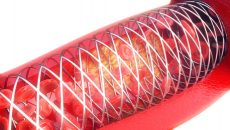In-stent restenosis (ISR) remains the main limitation in the percutaneous treatment of coronary artery disease, with a prevalence between 5% and 10% after implantation of latest-generation drug-eluting stents (DES). Therapeutic recommendations for it include the implantation of a new DES and the use of drug-coated balloons (DCB). The rate of recurrent ISR ranges from 10%…
Recurrent Revascularization at 10 Years after Percutaneous Treatment of DES In-Stent Restenosis
In stent restenosis (ISR) continues to be the main limitation to the percutaneous treatment of coronary artery disease, with 5 to 10% prevalence after new generation DES stenting. Guideline recommendations for this intervention include new DES stenting and the use of drug coated balloons (DCB). Recurrent ISR stenting rate ranges between 10 and 40%, and…
TCT 2023 | ISAR-DESIRE 3: 10-Year Results
In-stent restenosis (ISR) remains the primary limitation of percutaneous treatment for coronary artery disease. The strategy to address this limitation involves the use of drug-eluting stents (DES) or drug-coated balloons (DCB), both of which have proven to be effective and safe therapeutic alternatives. Despite current recommendations, treating ISR continues to be a challenge, and clinical…
TCT 2023 | In Stent Restenosis: Sirolimus vs. Paclitaxel Coated Balloons
This was a prospective, multicenter, randomized study including 130 patients with instent restenosis treated with sirolimus coated balloons (DCB S) and 128 treated with paclitaxel coated balloons (DCB P). Primary end point was late lumen loss (LLL) at 12 months. There were no significant differences between the groups. Mean patient age was 63, 75% were…
Intrastent Restenosis in Ostial Lesions in the Right Coronary Artery: Predictors of an Unfavorable Location
Predictors of intrastent restenosis in the right coronary artery ostium. The ostium of the right coronary artery (RCA) presents certain histological aspects. Atherosclerotic and fibrotic plaques in this area contain an abundance of smooth muscle, collagen, and a certain degree of calcification, along with thicker adventitia. Additionally, it has certain anatomical aspects such as poor…
Comparative Study of Two Drug Coated Balloons: Angiographic and Clinical Outcomes
The incidence of in-stent restenosis (ISR) requiring repeat revascularization ranges between 5% and 10% of PCI patients receiving new generation drug eluting stents (DES). This is why the current European guidelines on myocardial revascularization recommend treating ISR with drug coated balloons (DCB) with class I recommendation, level of evidence A. DCB are mostly coated with…
Should We Use Drug Coated Balloons in Patients with Multivessel Disease?
Recent studies have shown that a drug coated balloons (DCB) based approach resulted non inferior when compared against drug eluting stents (DES) only approach in patients with instent restenosis and de novo lesions in small vessel disease. So far, two international consensuses have reported the use of DCB is feasible and safe to treat native…
Intracoronary Brachytherapy for Drug-Eluting Stent Restenosis
3 Year Clinical Outcome Analysis and Failure Predictors in the Use of Intracoronary Brachytherapy for Drug-Eluting Stent Restenosis In-stent restenosis (ISR) has been one of the greatest obstacles standing in the way of long term patency in percutaneous coronary interventions. However, the use of drug eluting stents (DES) and their development has helped reduce ISR…





